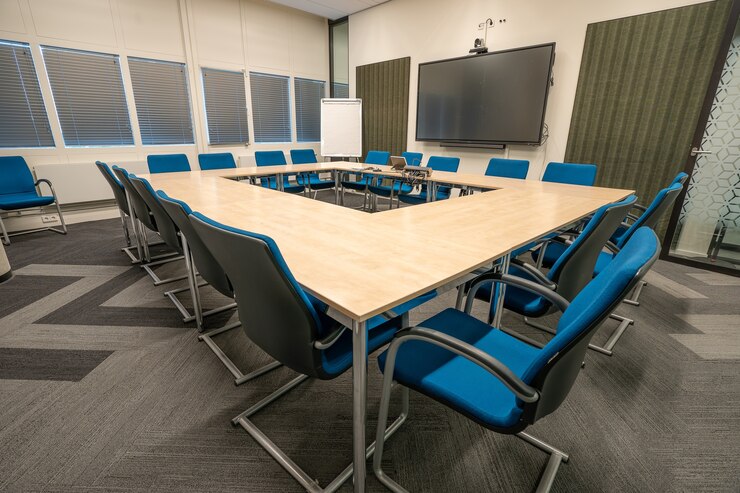Transforming Conference Halls into Ideation Hubs: Designing the Future
3 min read
Conference halls have long served as spaces for knowledge exchange, networking, and collaboration. However, in the rapidly evolving landscape of business and technology, there is a growing need to transform traditional conference halls into dynamic ideation hubs. This shift is essential to foster innovation, creativity, and meaningful connections among participants. Transforming conference halls into ideation hubs? In this article, we will explore various strategies and features that can elevate conference halls into ideation hubs, fostering an environment conducive to idea generation and collaboration.
1. Flexible and Modular Spaces:
Traditional conference halls often feature fixed seating arrangements and rigid layouts. Ideation hubs, on the other hand, thrive on flexibility. Designing conference spaces with modular furniture, movable partitions, and adaptable seating arrangements enables organizers to customize the setup based on the nature of the event. This flexibility encourages spontaneous collaboration and accommodates different styles of interaction.
2. Technology Integration:
The integration of cutting-edge technology is crucial in creating an environment that stimulates ideation. High-speed Wi-Fi, interactive displays, and virtual collaboration tools enhance communication and idea sharing. Augmented reality (AR) and virtual reality (VR) can be incorporated to create immersive experiences, pushing the boundaries of traditional presentations and workshops.
3. Inspiring Visuals and Artwork:
The aesthetic appeal of a space can significantly impact creativity. Incorporating inspiring visuals, murals, and artwork that align with the conference theme can create a visually stimulating environment. Art has the power to spark creativity and serve as a conversation starter, setting the stage for innovative thinking.
4. Collaboration Zones:
Breakout areas or collaboration zones within the conference hall encourage spontaneous discussions and idea exchange. These zones can be equipped with comfortable seating, whiteboards, and brainstorming materials. Providing spaces specifically designed for small group discussions fosters a collaborative atmosphere, allowing participants to delve deeper into topics of interest.
5. Inclusive Seating Arrangements:
Traditional rows of chairs facing a stage can create a hierarchical dynamic. Ideation hubs should embrace inclusive seating arrangements that promote equality and collaboration. Circular setups, lounge-style seating, and collaborative workstations contribute to a more democratic space where everyone feels empowered to contribute to the discussion.
6. Interactive Workshops and Activities:
To break away from the monotony of traditional conferences, organizers can incorporate interactive workshops and activities. These sessions engage participants in hands-on experiences, promoting active learning and idea generation. From design thinking workshops to hackathons, these activities can be tailored to suit the goals of the conference.
7. Mindfulness and Wellness Spaces:
Recognizing the importance of well-being in the creative process, ideation hubs should include mindfulness and wellness spaces. These areas can offer activities such as meditation sessions, yoga, or quiet corners for reflection. A balanced and relaxed mind is more likely to generate innovative ideas.
8. Green Design and Sustainability:
Sustainable design principles not only contribute to environmental conservation but also enhance the overall atmosphere of ideation hubs. Incorporating greenery, natural light, and eco-friendly materials creates a refreshing and inviting environment. Sustainability aligns with the values of many contemporary conferences and can be a source of inspiration for participants.
9. Culinary Experiences:
Food plays a crucial role in the overall conference experience. Ideation hubs can incorporate culinary experiences that go beyond traditional catering. Food stations, themed breaks, and interactive cooking demonstrations add an element of novelty, creating opportunities for networking and idea sharing in a relaxed setting.
10. Post-Event Collaboration Platforms:
The ideation process doesn’t have to end with the conference. Providing participants with post-event collaboration platforms, such as online forums or project management tools, ensures that ideas continue to evolve and collaborations persist beyond the conference days. This sustained engagement contributes to the long-term impact of the event.
Conclusion:
At Virtua Hub, transforming conference halls into ideation hubs requires a holistic approach that considers both physical and intangible elements. By embracing flexibility, technology, creativity, and inclusivity, organizers can create spaces that not only host conferences but also inspire innovation and collaboration. The future of conferences lies in the ability to provide participants with an immersive and dynamic experience that extends beyond the traditional boundaries of knowledge exchange.







